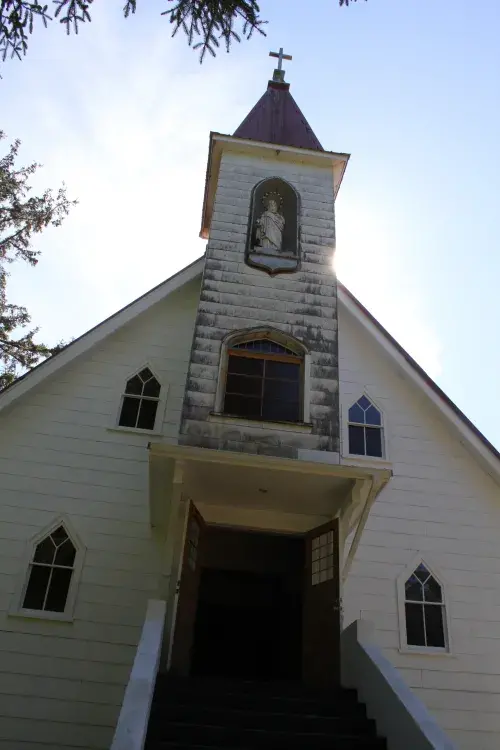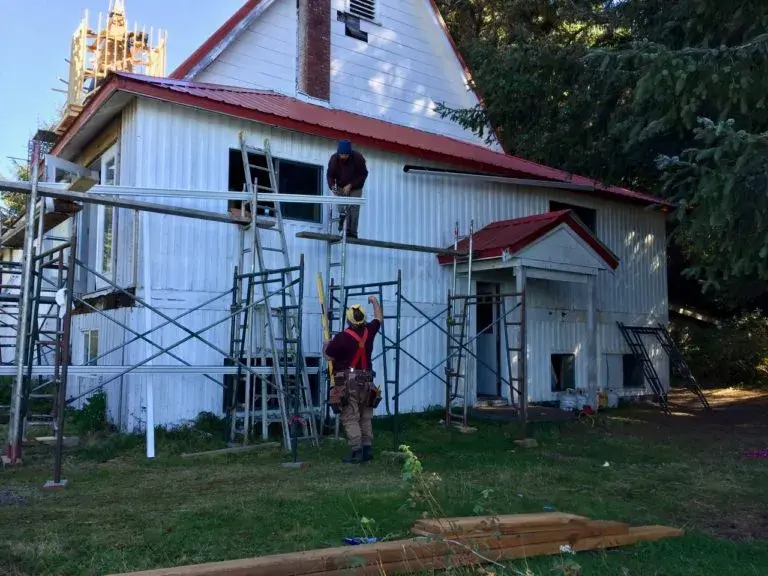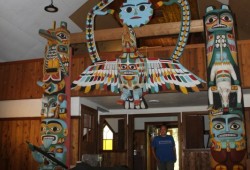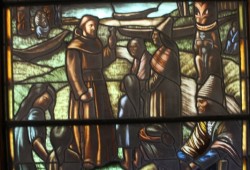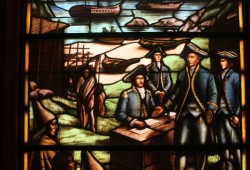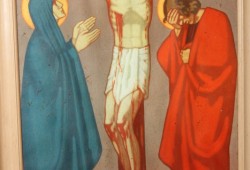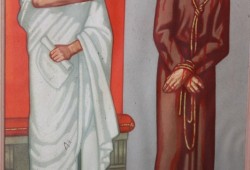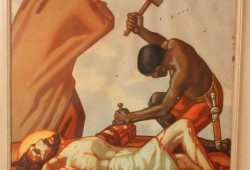Six years into a restoration project on the remote southern coast of Nootka Island, the exterior of the Yuquot church is expected top be completed this fall.
In early August members of the Mowachaht/Muchalaht First Nation held their annual camping event, celebrating the traditional summer village site that their ancestors congregated on for thousands of years. This summer the Yuquot church wore a fresh coat of paint, the latest upgrade to the building’s exterior, which has also benefitted from extensive repairs to the main roof and steeple, as well as replaced windows, doors, flashing and outdoor drainage.
“It was very damp, so we had to do the outside trench drainage. That’s what they’re finishing off now,” said Robin Inglis, a historian who has worked with the Land of Maquinna Cultural Society on the church’s restoration since 2015, two years before the physical work began.
The outside of the building is set to be completed by October, allowing the focus to shift to the interior, with hopes that over the next few years a gathering space that once existed in the basement can be rebuilt.
“The weddings occurred upstairs, but when everybody celebrated it was downstairs,” said Margaretta James, president of the cultural society.
“When it was a church, the basement was used as a community centre. There was a kitchen,” said Inglis. “It’s not always sunny in Yuquot, so it’s nice to have a place if people come.”
Yuquot is located approximately 30 kilometres west of the Gold River dock, a remote settlement where the Williams family are the only household to remain since the First Nation relocated a half century ago. Its rugged coastal location at the mouth of Nootka Sound has allowed contractors to work at the site for only a portion of the year.
The project has been funded through a cost-sharing program with Parks Canada, where the federal department matches expenses that are shouldered by the First Nation. Since 2017 up to $375,000 has been invested into the restoration project.
“It’s expensive to get the whole thing organized, bring out equipment, bring out professional people,” said Inglis, adding that a considerable amount of work is needed to bring the structure back to its original state. “In the 1990s they had done some work at the back in the priest’s quarters, and they had changed the configuration of church. So we had to go back and look at photographs and plans in diocese.”
It was the First Nation’s elders who stressed the importance of returning the church to its original state.
“It’s what the elders wanted. They wanted it returned to their memory,” said James. “It was the community hall where they gathered.”
Originally built in 1958 in the neo-Gothic style, the church features arched windows, buttresses, a bell tower and spire. At the time the church was dedicated to the Catholic Pope St. Pius X.
“The priest wanted the church built close to the centre of the village,” stated the Mowachaht/Muchalaht First Nation on its website. “Chief Maquinna refused to have the church there as it would be on his family’s traditional household plot. So the church was built where you see it now, on higher ground and tucked behind a tree-covered bluff for protection from the elements.”
A decade later the First Nation was in the process of moving its main reserve community to Ahaminaquus, south of Gold River on the Muchalaht Inlet. After many families left Yuquot the church was left to the elements over the following years.
“It’s a wooden building on the west coast. It can’t not be maintained, and that’s why it’s gone into such disrepair,” said Inglis. “The doors are not fitting, the windows were not fitting, and they changed a lot of the windows in the ‘90s, so we had to go back and make the custom-made windows to the original plans.”
In 1997 the Catholic church withdrew its authority from the structure, officially de-consecrating the building. But interest remained from the Mowachaht/Muchalaht, as elders recalled being married in the church when it served a central role for the community. Vibrantly coloured house posts and carvings were erected inside the building, at either end of its main hall. Carved and painted by artists Calvin Hunt, Tim Paul and Ron Hamilton, the pieces are replicas of what once stood in Yuquot big houses in the 1920s that were owned by the Jack and Maquinna families.
It's a striking combination of elements, in a building that still wears the mark of a Euro-centric worldview. At the church’s entrance are two stained glass windows that were donated by Spain in the 1950s, depicting Europeans in the centre as the local First Nations are in the darkened periphery.
“These windows are now jarring remnants from a colonial past,” explained the First Nation on its website. “One window shows representatives of Britain and Spain, Quadra and Vancouver, conferring about ‘sovereignty’ over Nootka Sound in 1791.”
But although concepts of the area’s history have changed since the Yuquot church was built 65 years ago, the Mowachaht/Muchalaht proudly encourage visitors to enter the building, which serves as “a community gathering place and interpretive centre,” according to the First Nation.
The existing building is the third Catholic church to be built at the ancient village site. The first such religious structure went up in the early 1790s, in the first era of contact with Europeans. At the time the Spanish established a naval outpost at Yuquot, aiming to defend the site from other explorers who might have reached the location from the north, via the Northwest Passage.
“Maquinna kept his people away, because they were always worried about their women being violated,” said Inglis. “In some ways, when the Spanish made a settlement, Maquinna moved out, they moved everything down the coast. They never really co-habitated in Yuquot.”
But by 1795 the Spanish left Yuquot when it was apparent that the passage through Arctic waters wasn’t possible. This move was welcomed by the local people, explained Inglis.
“There was always an idea that at some point they’re going to leave and we’ll get our village back,” said the historian. “In one Spanish journal I know of, a naval officer says, ‘They’re continually asking us when we’re going to leave’. I think there was some tensions. On the other hand, there was some interaction with trade.”
More than a century after the Spanish settlement was abandoned, Father August Brabant had a Catholic church built in 1889 as part of his mission in the area. This church was famously painted by Emily Carr during her visit to Yuquot. Brabant’s church burned down in 1954, which led to plans to build the structure that still exists today.

